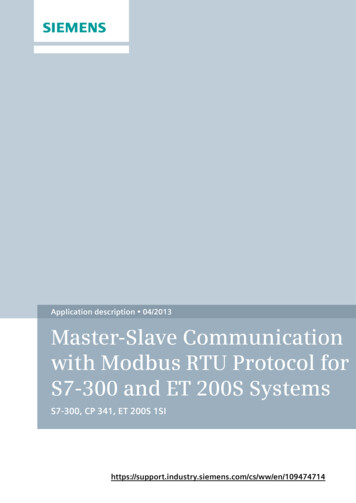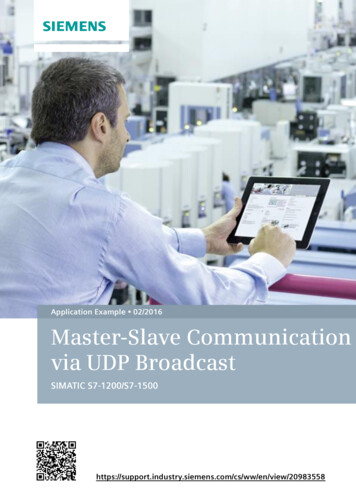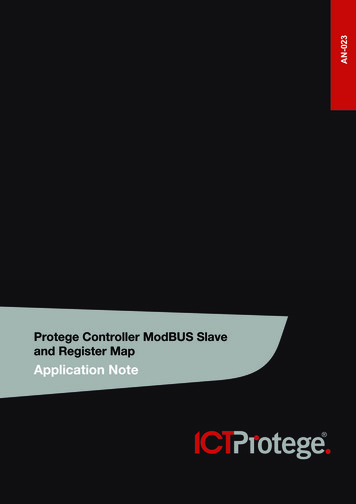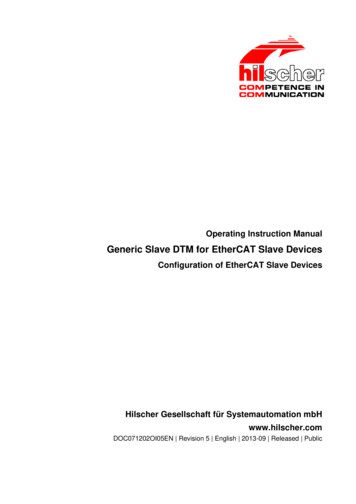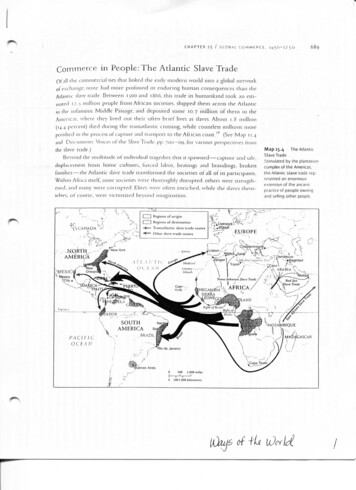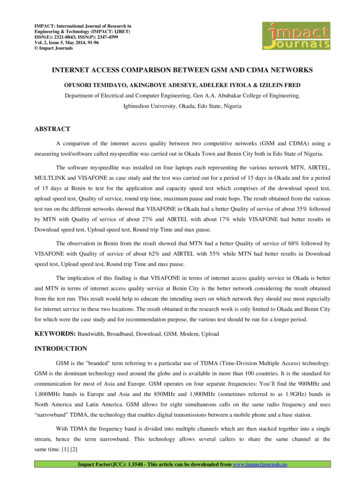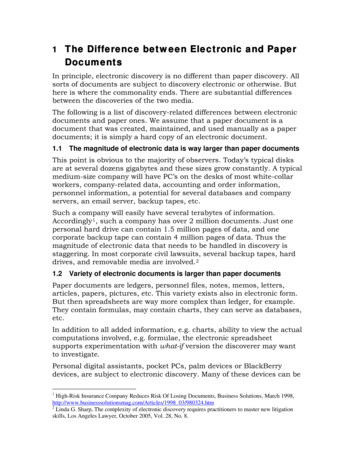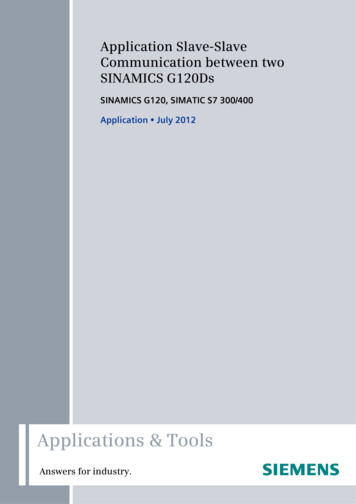
Transcription
DeckblattApplication Slave-SlaveCommunication between twoSINAMICS G120DsSINAMICS G120, SIMATIC S7 300/400Application July 2012Applications & ToolsAnswers for industry.
Siemens Industry Online SupportThis article is taken from the Siemens Industry Online Support. The following linktakes you directly to the download page of this view/en/ Item-ID CautionThe functions and solutions described in this article confine themselves to therealization of the automation task predominantly. Please take into accountfurthermore that corresponding protective measures have to be taken up in thecontext of Industrial Security when connecting your equipment to other parts of theplant, the enterprise network or the Internet. Further information can be foundunder the Item-ID view/en/50203404You can also actively use our Technical Forum from the Siemens Industry OnlineSupport regarding this subject. Add your questions, suggestions and problems anddiscuss them together in our strong forum community:Copyright Siemens AG 2012 All rights Slave-slave communication with two G120DsVersion 1.0, Entry ID: 60602336
sSINAMICSSlave-slave communication withtwo G120DsCopyright Siemens AG 2012 All rights reservedSlave-slave communication with two SINAMICS G120DsSlave-slave communication with two G120DsVersion 1.0, Entry ID: 60602336Task1Solution2Basics3Function mechanisms ofthis application4Configuring5Installation6Commissioning theapplication7Operation of theapplication8Further notes9Internet links - data10Contact person11History123
Warranty and liabilityWarranty and liabilityNoteThe Application Examples are not binding and do not claim to be completeregarding the circuits shown, equipping and any eventuality. The ApplicationExamples do not represent customer-specific solutions. They are only intendedto provide support for typical applications. You are responsible for ensuring thatthe described products are used correctly. These application examples do notrelieve you of the responsibility to use safe practices in application, installation,operation and maintenance. When using these Application Examples, yourecognize that we cannot be made liable for any damage/claims beyond theliability clause described. We reserve the right to make changes to theseApplication Examples at any time without prior notice.If there are any deviations between the recommendations provided in theseapplication examples and other Siemens publications – e.g. Catalogs – thecontents of the other documents have priority.We do not accept any liability for the information contained in this document.Copyright Siemens AG 2012 All rights reservedAny claims against us – based on whatever legal reason – resulting from the use ofthe examples, information, programs, engineering and performance data etc.,described in this Application Example shall be excluded. Such an exclusion shallnot apply in the case of mandatory liability, e.g. under the German Product LiabilityAct (“Produkthaftungsgesetz”), in case of intent, gross negligence, or injury of life,body or health, guarantee for the quality of a product, fraudulent concealment of adeficiency or breach of a condition which goes to the root of the contract(“wesentliche Vertragspflichten”). The damages for a breach of a substantialcontractual obligation are, however, limited to the foreseeable damage, typical forthe type of contract, except in the event of intent or gross negligence or injury tolife, body or health. The above provisions do not imply a change of the burden ofproof to your detriment.Any form of duplication or distribution of these Application Examples or excerptshereof is prohibited without the expressed consent of Siemens Industry Sector.4Slave-slave communication with two G120DsVersion 1.0, Entry ID: 60602336
PrefacePrefaceObjective of the applicationThis application should provide electrical application engineers and the associatedcommissioning engineers with guidelines to engineer and commission a simpleleading/following drive for an existing SIMATIC S7 control system.Main contents of this application noteThe following main points are discussed in this application note: Direct communication between two DP slaves using slave-slavecommunication. Master/slave operation (leading/following drive). Step-by-step configuring of the SIMATIC S7 and the drives for master/slaveoperation.Copyright Siemens AG 2012 All rights reservedValidityThis application has been written for a SINAMICS G120D with a CU240D-2 DP V4.5, but is also basically possible using a SINAMICS G120 with a CU240E-2 DP /CU240B-2 DP and a PM240 / PM250 as well as a G120C.The SINAMICS G120P with its PM230 has been developed for pump, fan andcompressor applications, and is not taken into consideration in this applicationdescription.Know-how that is requiredIt is assumed that readers have basic knowledge about handling SIMATIC S7,cyclic data exchange via PROFIBUS, STARTER commissioning software and drivetechnology.Slave-slave communication with two G120DsVersion 1.0, Entry ID: 606023365
Table of contentsTable of contentsWarranty and liability.4Preface .51Task .71.12Solution .82.12.22.2.12.2.22.2.32.32.43Copyright Siemens AG 2012 All rights ration of the application.418.18.28.36Installing the hardware .32Installing the scripts provided .33Installing the SIMATIC project provided .38Commissioning the application .397.17.28Configuring slave-slave communication in the hardwareconfiguration.20Configuring the drives in the SIMATIC project .23Go online with STARTER and parameterize the master drive .25Go online with STARTER and parameterize the slave drive.29Installation .326.16.26.37Functionality of the program provided .17Program details for block FB1 .17Functionality of the slave-slave communication .19Details for data exchange between two drives.19Configuring .205.16Basics Slave-slave communication for drives .13Basics, master/slave drive.14Function mechanisms of this application.164.14.1.14.24.2.15Overview of the total solution .8Description of the core functionality .9Parameterizing the communication .9SINAMICS .9SIMATIC S7-300/400 .9Data exchange .9SINAMICS G120 .9To be carefully observed when commissioning the drives .10Typical application areas.10Hardware and software components used.11Alternative solutions .12Basics.133.13.24Description .7Scenario, only the master drive.42Scenario, only the slave drive .42Scenario, the master and slave drive together.439Further notes .4410Internet links - data .4511Contact person .4512History .45Slave-slave communication with two G120DsVersion 1.0, Entry ID: 60602336
1 Task1.1 Description1Task1.1DescriptionFor drives that are rigidly connected with one another, often one drive is operatedas the leading drive (master) in speed control. The other drive or drives receive thetorque setpoint from the master as setpoint and are operated as slave drive intorque control.This application example shows how you can parameterize two SINAMICS G120Ddevices as master/slave drive, and how you can configure direct communicationbetween the drives based on an existing SIMATIC S7-300/400 control system.This application can also be realized using another SINAMICS G120 converter,assuming that a CU240x-2 DP is used.Overview of the automation taskThe figure below provides an overview of the automation task.Copyright Siemens AG 2012 All rights reservedFigure 1-1 Figure 1-2 Overview of the taskOverview of the automation taskFor two rigidly connected drives, one operates as master drive in closed-loopspeed control. The slave drive, which is operated in closed-loop torque control,receives the setpoint torque of the master as main setpoint and is operated as aslave.The higher-level control system identifies if one of the two drives fails. Using aselector switch, the operator deselects master/slave operation and selects the drivewithout fault. The load is moved with reduced velocity, e.g. with the pre-limit switchvelocity or with crawl velocity to a maintenance position.The preselection of the operating modes, master alone, slave alone, master slave together, the velocity setpoints as well as the evaluation of the status wordsand the control itself is realized in the PLC.Slave-slave communication with two G120DsVersion 1.0, Entry ID: 606023367
2 Solution2.1 Overview of the total solution2Solution2.1Overview of the total solutionSchematicThe most important components of the solution are schematically shown in thefollowing diagram:Copyright Siemens AG 2012 All rights reservedFig. 2-1 Schematic representationThe example shows you . the basic design, if a drive is operated as master in speed control (n control)and the slave drive in torque control (M control). . where you can find the current GSD files. . how a SIMATIC S7 CPU319-3 PN/DP is parameterized for simple slaveslave communication without Drive ES Basic. . the most favorable drive parameterization, based on the I/O configuration 7(macro 7).DelimitationThis application does not include. . drive dimensioning. . drive commissioning. . complete programming of a drive control. Only a data block and a variabletable are provided, as example for data transfer and to illustrate slave-slavecommunication. . Safety integration.A basic knowledge of these topics is assumed.8Slave-slave communication with two G120DsVersion 1.0, Entry ID: 60602336
2 Solution2.2 Description of the core functionalityRequired know-howIt is assumed that the reader is knowledgeable about how to use SIMATIC S7,cyclic data exchange via PROFIBUS, the STARTER commissioning software aswell as drive technology2.2Description of the core functionality2.2.1Parameterizing the communicationSINAMICSSINAMICS is parameterized using the STARTER V4.3 SP1 commissioning tool.For SINAMICS G120D V4.5, the PROFIBUS address can either be permanentlyset using a DIP switch, or if all of the DIP switches are set to ON or OFF, usingparameter 918.Copyright Siemens AG 2012 All rights reservedThe remaining PROFIBUS parameters (e.g. baud rate) are automatically identified,or transferred from the PROFIBUS master at power-up so that these do not have tobe parameterized.For SINAMICS, a telegram type for data exchange can be selected from severaltelegram types. This therefore defines which data are sent and received in whichsequence. When parameterizing the control it is important that the same telegramlength and the same telegram type are selected.SIMATIC S7-300/400In this example
This application example shows how you can parameterize two SINAMICS G120D devices as master/slave drive, and how you can configure direct communication between the drives based on an existing SIMATIC S7-300/400 control system. This application can also be realized using another SINAMICS G120 converter, assuming that a CU240x-2 DP is used.
